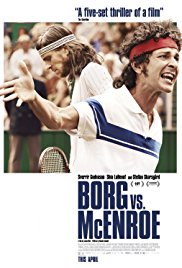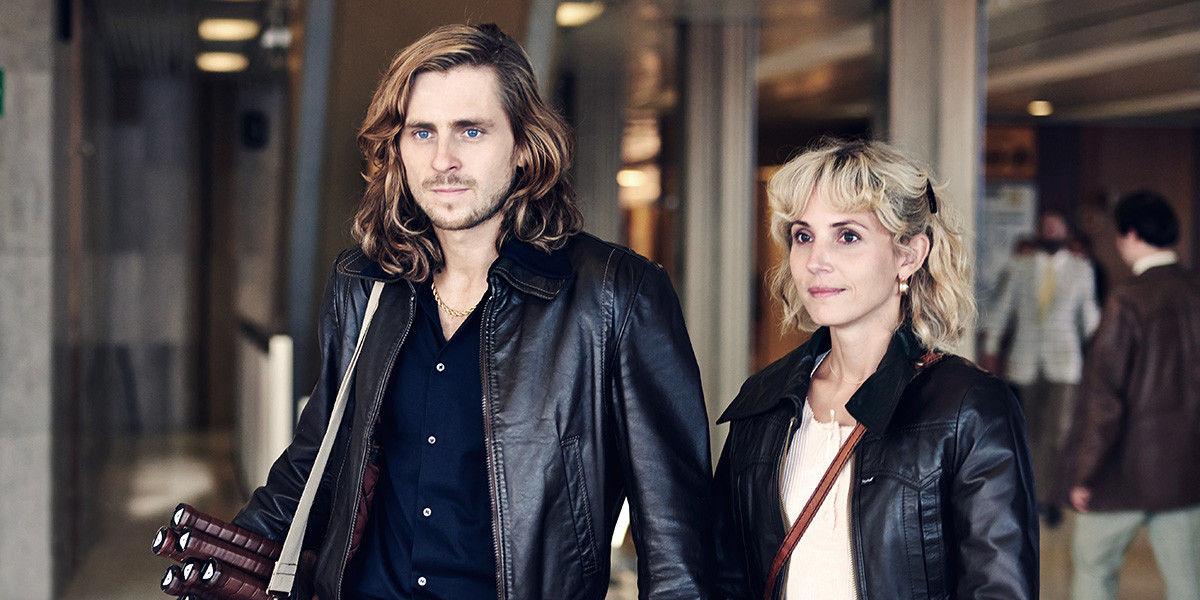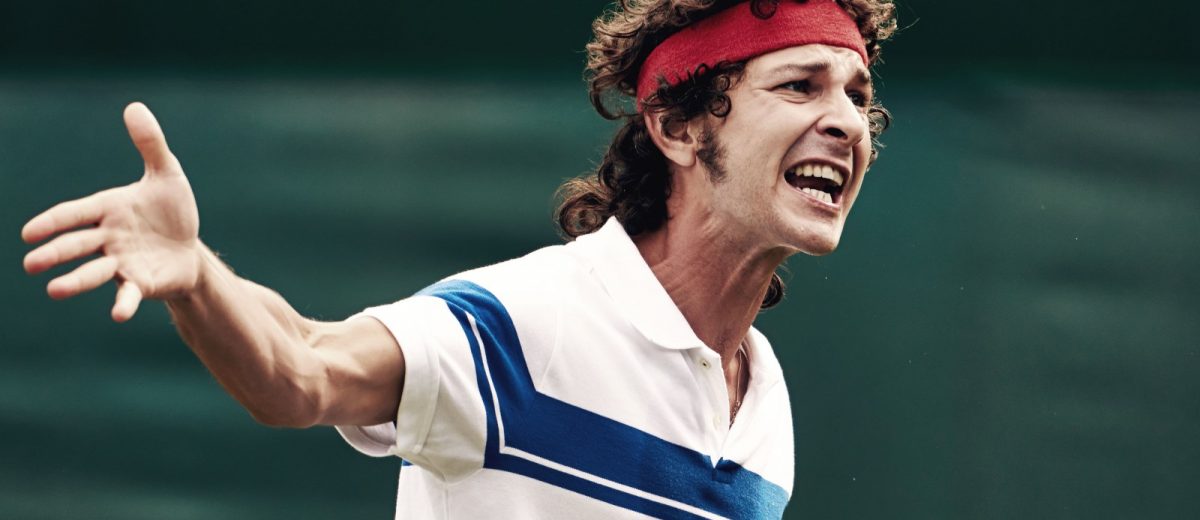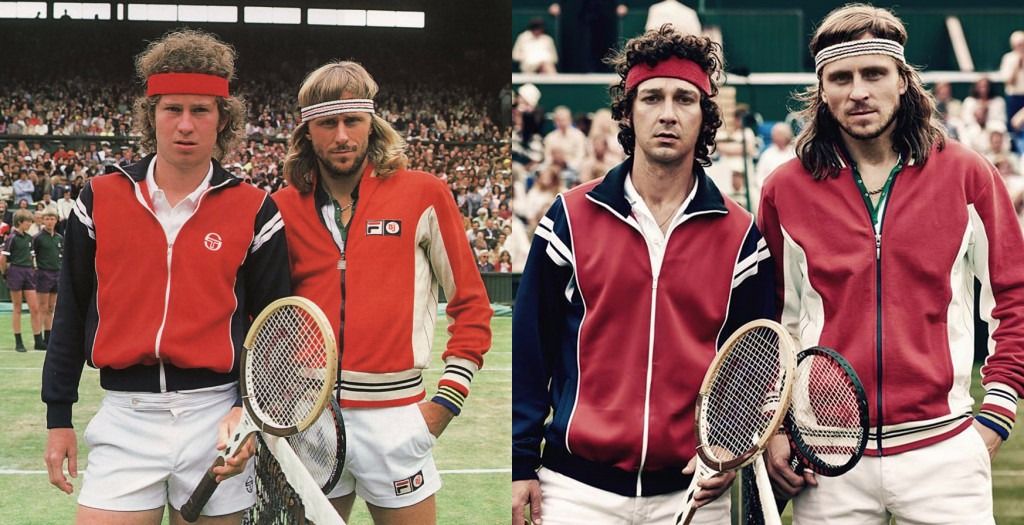Two Tennis Greats and the Finals Match That Brought Them Together.
DIRECTED BY JANUS METZ/2018

The documentary director of Armadillo, Janus Metz, directs his non-documentary feature film debut with the sports film Borg vs. McEnroe. Chronicling the classic 1980 Wimbledon final between the number one tennis player in the world, Björn Borg, and the number two player, John McEnroe. Borg vs. McEnroe is a fantastic back and forth look at two tennis greats and the finals match that brought them together and gave us one of the greatest contests ever seen.
While the entire film takes place within this one Wimbledon event in 1980, the lives of both of these tennis legends is examined thoroughly. Like the documentarian that he is, Metz weaves the scenes of both Borg and McEnroe’s past in and out of the current setting in an effective way that properly builds the tension and transcends the established stereotype of both players. This of course starts with the script from Ronnie Sandahl (Underdog) which grounds it all before Metz’s visual vision brings it all to life.

While Björn Borg (Sverrir Gudnason) is thought of as a very stoic player, the antithesis of the always volatile McEnroe (Shia LaBeouf), the backstory we learn of both men paints a very different picture than maybe the one we know. The man, Björn Borg, who had won four straight Wimbledon titles and who was playing for his unprecedented fifth straight title in 1980, was a man of total control. He had been called a machine by McEnroe.
He never broke his routine. Ever. He practiced the same way, on the same court, every day. He slept with the room at a chilly temperature to ensure a certain heart rate. He was picked up at the airport and driven in the same car, with the same interior, and settings. The night before a match, he and his longtime coach Lennart Bergelin (Stellan Skarsgård) would evaluate and rank 50 tennis rackets for all of the possible differing conditions in the next day’s match. This ranking could be based on the tension of the strings, to the potential climate. Every possible circumstance and scenario was considered in their decisions. Borg was thought to not feel things like pressure. He simply would win.

McEnroe, on the other hand is the brash, loud, foul-mouthed American, known to scream “You cannot be serious!” at the judges. He is hated by his fellow players, and has even been booed in England for his tainting of what has long been held as a “gentleman’s sport”, given his very undignified antics. McEnroe doesn’t seem to care. He is likely to go off at a moment’s notice, especially when giving interviews that don’t ask about him, or his playing, but instead want to know his thoughts about Borg.
Despite being seemingly polar opposites, both are very adept students of the game, and each other. As the press conferences and sound bites begin to fade and Round 1 of Wimbledon begins, both players reveal a hidden depth that lurks beneath their public facade. For McEnroe, we see that is able to put aside the bluster in order to rise to the challenge of playing someone as calm and cool as Borg. Even though he might constrain his outbursts, his passion is clearly and visibly bubbling under the surface of every shot, look, and emotion.

For Borg, he sees past what everyone else sees in McEnroe, namely the shouting, cussing, and on-court antics. Borg’s fiancee, tennis great Mariana Simionescu (Tuva Novotny) even thinks McEnroe is a joke as they watch his match. The press agrees labeling McEnroe a “Brat”. Borg, however, rebukes her a bit as he sees a method to the madness. It is then we are given glimpses back to when Borg was younger, from ages 9-15 (played by both Leo Borg-Björn Borg’s real life son, and Marcus Mossberg).
It seems that Björn was not always the calm, focused, non-emotive player that the world knew. He too was prone to outbursts, and passionate anger. He understood just how focused McEnroe’s public displays actually were. His cool, calm, demeanor is something he trained himself to do, but it still resides deep within him, fueling his drive and steel resolve.
This sets up the final match, and like all great sports films, the tension is always highest in this last event, the one that will determine a champion. Borg vs. McEnroe is a film that is totally accessible to the non-tennis fan. Janus Metz draws you into this battle with the subtle back and forth of his alternating camera angles, and by providing an on-screen score of the match, which gives one the feeling as if you were watching it on your own television in 1980. There is also enough explanation of the specifics of a match to keep the uninformed completely up-to-date.

The real selling point of this whole thing is the depth of story and the powerful performances of Shia LaBeouf and Sverrir Gudnason. LaBeouf completely disappears into the role and frankly demonstrates a range that should bring him more opportunities in the future, if he, like McEnroe, can just seem to reign in the demons they carry in their personal life. He has shown flashes of this in the past, but his portrayal of McEnroe is probably the most complete transformation I’ve seen him make for a part. Gudnason was completely new to me, despite having a very long resume in mostly Swedish film. Unfortunately, I haven’t seen him in a film prior to this, but he was excellent in this role, and I would look forward to seeing any of his future projects.
I can agree with the chorus of reviewers who have declared Borg vs. McEnroe the greatest tennis film, ever. It is also a solid drama that highlights what has been described as the greatest Wimbledon finals match to ever be played on center court. For those who know their history, it will be no surprise who won, but for everyone else, without looking it up online, go and see Borg. vs. McEnroe and find out.
Borg vs. McEnroe will open today at the Alamo Drafthouse in Houston, and all across the country.


